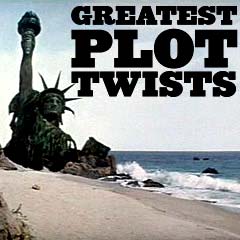
|
|
|
||||||||
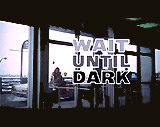
|
Wait Until Dark (1967)
Director Terence Young's suspense thriller was known for its harrowing, tremendously-scary finale. Its tagline was:
In the story, the main focus of attention was on drugs (heroin), sewn up inside a baby doll. There were three different con-men searching for the valuable doll:
In the film's opening sequence, fashion model Lisa (Samantha Jones) (later identified as Roat's wife) arrived with the doll after an international plane flight from Montreal to NYC's JFK airport. Tense and nervous about her situation, she gave up the doll (for safe-keeping) to a fellow passenger (and stranger):
Then, shortly later, Talman discovered her body. She had been suffocated to death in a garment bag by her psychotic husband Roat - he claimed an alleged double-cross. Roat then framed and blackmailed Talman and Carlino as Lisa's killers, unless they located the missing heroin. The two cons believed that the doll was in the tiny NY basement apartment of Sam's blind, yet self-reliant housewife Susy Hendrix (Audrey Hepburn). They didn't know that for awhile, the doll had been taken by Sam's exasperating young next-door neighbor Gloria (Julie Herrod). Talman and Carlino used every elaborate scheme and manipulative tactic they could think of to dupe the helpless Susy into giving up the doll - that she knew nothing about. With the help of Gloria, Susy determined that the three men were imposters acting out roles (a police officer/detective, a friend of Sam's, etc.) for some nefarious reason. There was a final battle of wits after the villainous and crazed Roat had killed his two associates. He doused the entire apartment with gasoline from a red container and then threatened to set everything on fire with a burning, rolled-up newspaper. She retaliated by throwing a chemical into his face and smashing all the lights, leaving the apartment in complete darkness (she had earlier closed all the blinds). When he again taunted her with a lit-match, she began spraying and dousing him with some of the left-over gasoline in the container ("Try lighting a match now, Mr. Roat! Throw your matches over to me"). To keep him at bay, she lit the matches one by one, threatening to ignite him, and forced him to tap the floor with her cane to indicate his location. He outwitted her by opening the refrigerator door to provide the room with light, and permanently propped it open with a towel ("Well, Susy, it's all over"). He coerced her to give up the doll, and then was about to possibly rape and kill her ("Well, Susy, now I want you in the bedroom"). In the bedroom, she surprised him by stabbing him in the abdomen with a kitchen knife, but then couldn't escape his crazed pursuit and get out of the locked apartment. In the film's jump-scare moment, the ruthless Roat lunged with a knife from the dark hallway toward Susy as she raced to the kitchen and struggled to shut the refrigerator door. She survived Roat's brutal assault as her crawled toward her (using the knife as leverage) by hiding behind the refrigerator door (the open door lighted the room before she pulled the plug). The scene ended in total darkness with the sound of her anguished screams.
At film's end, she slowly emerged as the sole survivor, crouched in the corner behind the refrigerator door. |
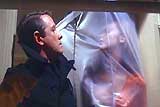 Dead Lisa (Samantha Jones) 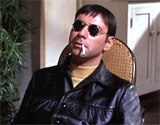 Roat (Alan Arkin) 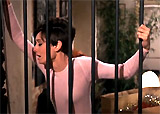 Susy Hendrix (Audrey Hepburn)   Terrorizing Susy (Audrey Hepburn) With Fire  "Try lighting a match now, Mr. Roat!"  The Doll  The Jump-Scare Moment  Crawling with Knife |
||||||

|
Waking Life (2001)
This was an off-beat, fresh, rambling, dream-like creatively-imaginative animated film (originally a live-action film that was later painted - or rotoscoped - with a computer process) that followed the disconnected thoughts and inner discussions of the nameless main character, the Dreamer (voice of Wiley Wiggins). Accused of being pseudo-intellectual, this free-floating unique fantasy-drama presented a collage of images as it philosophically contemplated the illusionary nature of reality. It proposed a variety of existential ideas and questions about life's many mysteries. The Dreamer's main question was how to distinguish the absolute difference between his waking life and the dream-world. The young Dreamer became panicked over his inability to wake up from what he thought was a persistent "dream." He experienced many "false awakenings" from his dreamworld state, and obsessed over the prospect that he was actually dead or in the process of dying, or forever stuck in a dream state. He wondered whether human beings can control their dreams, and what did dreams tell us about life and death. Various segments (or lucid dreams) were presented by various other characters, including:
The film concluded with the Pinball Playing Man (director Richard Linklater), while playing a game of pinball, offering lengthy advice about existence to the Dreamer, who worried: "I'm starting to think that I'm dead." He described a dream he once had after he had read an essay by science-fiction writer Philip K. Dick, who had a theory that time was an illusion:
The Dreamer then responded, by complaining about feeling trapped in his own dream world:
The Pinball Playing Man provided the last spoken lines of the film: "Just Wake Up":
The Dreamer woke up (another false awakening into another dream?), walked outside onto the street, then onto a home's lawn, and suddenly floated into the air until he was only a tiny speck of nothing far up in the sky - an ambiguous ending.
|
 The Boat Car Guy (Bill Wise)  Celine and Jesse (Julie Delpy and Ethan Hawke)  Steven Soderbergh (Himself)  Timothy ' Speed' Levitch (Himself)  The Dreamer (Wiley Wiggins)  Pinball Playing Man (Richard Linklater): "Just Wake Up!"  The Dreamer Waking Up to Life  The Dreamer Walking On Street and Onto Lawn  Levitating or Floating Into the Air |
||||||

|
Walkabout (1971, Australia, UK)
This was a haunting Australian film from director Nicolas Roeg - his directorial solo debut. Its taglines were:
It opened with the shocking suidice of a crazed geologist father (John Meillon), who had taken his two children to the Australian bush for a picnic, then set their car on fire, and shot himself in the head (after aiming at them):
The two stranded children wandered to a location of a lone fruit tree and a pool of water. When those vanished soon after, they were saved after meeting up with a teenaged aborigine boy (David Gulpilil) during his 'walkabout' (to prove his manhood). In the stunning ending, the native aborigine - with a painted skeleton on his body - performed a silent, ritualistic mating dance for the civilized, repressed girl at a deserted farmhouse. She ignored and resisted his (and her own) sexual rite of passage, by continuing to treat him as a detached servant -- with disastrous results. After the aboriginal danced all night and became weary, she found him the next morning hanging dead in a mango tree, and she barely reacted. The film ended years later with the young girl now married and returned to civilization, living in a high-rise apartment complex. She was wishfully daydreaming back to her days in the outback when she happily swam naked with the aboriginal and her young brother.
They were long-gone days of paradise lost, referred to in the voice-over reading of one of A.E. Housman's poems in A Shropshire Lad:
|
 Suicidal Death of Father  Aborigine Boy (David Gulpilil) with Girl and Her Brother  Mating Dance   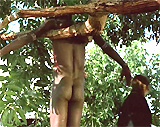 Aborigine's Hanging Death |
||||||

|
Wanted (2008)
Russian director Timur Bekmambetov's dark and brutal action summer blockbuster (his first English-language film) was loosely based upon the superhero comic book miniseries titled Wanted by Mark Millar and J. G. Jones. Its tagline was:
The Matrix wanna-be sci-fi film with mind-bending special effects centered around the existence of a one-thousand year old association or clan of weavers known as The Fraternity in eastern Moravia that had formed a secret society of assassins. Their slogan was to carry out executions ("kill one and maybe save a thousand") to maintain stability, balance and peace in the chaotic world. The central character was:
He was a frustrated, aimless and broke, apathetic, hypochondriac, weak and wimpy ("pussy") account manager in Chicago, with a demanding and obese donut-loving corporate boss named Janice (Lorna Scott). At home, anxiety-prone Wesley had an unhappy relationship with his cheating and bickering girlfriend Cathy (Kristen Hager), who was having sex with his co-worker and best friend Barry (Chris Pratt), but Wesley did nothing to stop it. In a drug store pharmacy, Wesley was confronted by mysterious, anorexic Fraternity member Fox (Angelina Jolie), who claimed that she knew his recently-murdered father, an elite professional assassin - and "one of the greatest assassins who ever lived." Wesley responded that his father had deserted his family when he was one week old. To his further surprise, she rescued him (actually herself!) in the store from being assassinated by a killer:
Cross was thought to have betrayed Wesley's father before killing him in cold blood, and was now hunting and gunning down the members of the Fraternity one-by-one.
After a thrilling shootout and car chase, Fox introduced Wesley to the brotherhood's current leader - enigmatic Sloan (Morgan Freeman). The Fraternity's headquarters were in a textile mill factory-fortress, a large warehouse. To his astonishment, Wesley was able to shoot the wings off three flies with six bullets. Because of his enormous hidden gifts and rare superhuman abilities inherited from his father, he was recruited to join the shadowy underground Fraternity (to follow in his father's footsteps). After he quit his job with newfound confidence in himself (after inheriting his father's fortune of over $3 million), Wesley was brought to the Fraternity to be inducted.
He was repeatedly beaten to a bloody pulp, then often taken to a Recovery Room area where he was healed from his wounds in hours, not days, in a white waxy bath. With Fox as his mentor, he was eventually taught to control his innate bursts of adrenaline, strength, speed, dexterity and reflexes. Importantly, he was trained to shoot bullets to curve around objects (similar to The Matrix's innovative 'bullet time'). He learned about a Loom of Fate that created fabrics with hidden woven binary codes ("a mystical language") that identified names of future targets to be assassinated. Sloan gave Wesley an objective after some practice missions - to pursue and kill his father's own murderer: Cross. Sloan considered Wesley as "the only one who can get to him." At the same time, the double-crossing Sloan also assigned Fox to execute Wesley, explaining that his name had also come up in the Loom. A few major plot twists were revealed:
Rather than pursuing a peaceful life that his father wanted for him by fleeing the country with a Sovereign Airways economy ticket, an enraged Wesley decoded the next fateful Loom execution - Sloan himself. He used his father's own detailed maps, plans and weapons (found in a secret room) to assault the textile factory (with thousands of rats with explosive devices strapped to their backs). Within the mill during a final confrontational standoff in Sloan's circular office (Wesley to Sloan: "You're just a thug who can bend bullets"), Fox sacrificed herself by killing the last remaining Fraternity members with a curved bullet (marked GOODBYE) to their heads (including her own), to fulfill the Loom's wishes. Meanwhile, Sloan escaped. In the startling, plot twist ending, Sloan was still plotting to kill Wesley. He approached behind a man seated at a computer in a work cubicle who was typing the name "Wesley Gibson" into a Google search box (with no results found). Sloan held a gun to the back of the person's head, thinking it was Wesley. When the worker turned around, he revealed himself to be a decoy. Sloan (who was standing on an X mark made with Post-it notes) was shot and killed by Wesley with a long-distance bullet (similar to the film's opening action scene). Its slow-motion trajectory, played backwards from his father's apartment, traveled through objects of key individuals in Wesley's life before striking Sloan in the head: his boss's donut, and his ex-best friend's power drink can. In voice-over, Wesley spoke about how his 'nobody' life had now - after six weeks - become a success story:
Wesley then turned to the audience, next to the high-powered gun scope-sight, with a taunting closing-curtain line: "What the f--k have you done lately?" |
 Wesley Gibson (James McAvoy)  Slow-Motion Trajectory of Bullet Reversed  The Two-Windowed Apartment With Porch  Cross (Thomas Kretschmann)  Sign: "Your Father's Son"  Cross' Apartment  Fox (Angelina Jolie)  Sloan (Morgan Freeman)  Wesley Shooting Cross on Derailed Train  Cross' Confession That Wesley Was His Son  Wesley's Shocked Reaction to Killing His Own Father  "You are the only person he (Cross) wouldn't kill."  Fox's Self-Sacrifice After Murdering Fraternity Members  Sloan Killed  Last Line: ""What the f--k have you done lately?" |
||||||

|
The War of the Worlds (1953)
Paramount's Technicolored science-fiction, alien-invasion film from director Byron Haskin (and producer George Pal), was loosely adapted from British author H.G. Wells' 1898 novel (of the same name). It was about a Martian invasion of Earth, occurring in 1950s Southern California near Los Angeles.
It was an historically-interesting film, the grand-daddy of alien attack films during the Cold War era, which won the year's Academy Award for Best Special Effects. The film was preceded in 1938 by Orson Welles' Mercury Theater on the Air radio version which shocked listeners who thought there was a real invasion occurring in Grover's Mill, New Jersey. Even one of the film's taglines brought up fears of a real invasion:
Another tagline warned not to spoil the film's ending: "Don't Tell How It Ends!" In the film's opening, the commentator (Sir Cedric Hardwicke) explained how Martians wished to migrate to Earth, to colonize the thriving planet:
Meteorites landed in a California forest in the small town of Linda Rosa. When a trio of townsfolk approached the downed spacecraft with a truce flag after the object's hatch unscrewed itself, they were vaporized by a blast from a tentacled, cobra-snake-like heat ray (or disintegrator beam) appendage, emanating from a sleek, hovering manta ray-like flying machine. The warring invaders begin an assault on Earth, and destroyed everything that resisted - by employing protective force-fields. The dropping of an A-bomb was ineffective - one of the Martian flying machines, seen in a binocular view, emerged unscathed from a cloud of dust. One of the military generals, Maj. General Mann (Les Tremayne) was dismayed:
Soon, Los Angeles was evacuated as the Martians were proceeding to conquer the world, and mobs of people panicked during their flight. The two major characters had become separated:
A number of survivors were praying for salvation in a church when the Martian assault began (the stained-glass window was shattered and the light fixtures from the ceiling crashed to the floor). After the dust cleared, Clayton and Sylvia were seen hugging each other. And then the first of many Martian flying ships crash-landed or collapsed, failing to function any longer. Suddenly, everything was quiet. Through the open wall of the church building, the church's survivors looked upon one of the Martian vessels that had ceased its attack. Clayton slowly approached the opening hatch of the spaceship, where an elongated arm from a Martian creature extended out. A second spacecraft also crashed nearby. He wondered to himself: "Something's happened." The Martian arm then changed color and stopped moving.
Clayton moved closer for a better look and declared: "It's dead. We were all praying for a miracle." He looked up and heard church bells ringing. Miraculously, the Martian threat had fallen prey to bacterial infection (an ironic twist), both in SoCal and throughout the world (New York, Paris, Rio, India, etc.), and the aliens perished. The commentator intoned (Sir Cedric Hardwicke, again in voice-over) that God had saved humanity by "the littlest things":
The film ended in an uplifting scene with survivors standing on a hillside thankfully singing hymns. |
 A Flaming Meteor  A Tentacled, Cobra-Snake-like Heat Ray on Martian Alien Spacecraft 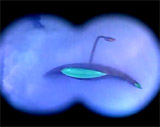 Unphased by Nuclear A-Bomb  Evacuation of LA  Assault of the Martians  Sylvia Van Buren (Ann Robinson)   Clayton (Gene Barry) with Sylvia in Church  Disabled Crashing Martian Spacecraft  "Something's happened."  The End of the Threat World-Wide  The Uplifting Ending |
||||||

|
Water Drops on Burning Rocks (2000, Fr.) (aka Gouttes D'Eau Sur Pierres Brûlantes)
Director Francois Ozon's four-act, dark comedy/tragedy was set in 1970s Berlin Germany and confined to the interior of the apartment of the central character. It examined both homosexual and heterosexual relationships through two characters:
By the end of Act 1, they had consummated their sexual love for each other in the bedroom, indulging in Franz's fantasy of a "dream man" - a stranger coming to bed wearing an overcoat. Six months later, Act 2 found them at odds with each other, getting on each other's nerves, and constantly bickering, but their sex life remained good (Franz: "I never want another man after you"). Soon, they contemplated splitting up (Leopold: "We're good together, we just can't live together"). Things would change for the gay couple with the sudden arrival of the two ex-loves of both males in the remaining acts:
Franz rekindled love and the joy of sex when rejoined, during a surprise visit while Leopold was away, with his ex-fiancee Anna - they had known each other for almost four years. After her arrival, he noted that she had changed - looking at her bounteous chest: "You've changed, for the better. You're much prettier." He acted out the 'man-in-overcoat' fantasy with her before love-making (Anna later described their sex: "We've made love for two days straight. We got lots of pleasure"). In Act 4, they planned to move out, get a house and have children together to start their lives over ("...now we're together and we'll make it"), when Franz realized he couldn't have abandoned Leopold by himself without her - he admitted: "I think I still love him," and was saddened by the thought. Leopold's ex-lover Vera of seven years, who had undergone a sex change operation (according to Leopold, she was "a former buddy who cut his dick off in Casablanca"), also arrived on the scene. Anna was intrigued by the company: "I want to stay awhile. The situation is so exciting." By the end of this nihilistic film, in the midst of sexual game-playing, Leopold commanded the humiliated group: "Everyone in the bedroom" - and both Anna and Vera were especially excited about the prospects of going to bed with him. Franz fantasized about murdering Leopold by shooting him during his threesome while he made love to the other two women. During their threesome, Leopold showed a sexual preference for the younger Anna, and Vera left the bedroom (as Franz noted: "Fresh flesh wins out"). In the living room, Franz commiserated with fellow outcast Vera who soon left the bedroom (after Leopold showed a sexual preference for the younger Anna, as Franz noted: "Fresh flesh wins out"). Vera was sorrowful about her condition: "I've suffered in every way imaginable. So much sadness....I'll suffer forever...I'm his creature." She admitted that she was "starved for love" when she first met Leopold, and he was good to her and she was happy until he stopped desiring her. Vera admitted that when Leopold stopped loving her, she took a drastic, love-crazy measure: "I had a sex change for him, out of love for him, so he'd want me again. I was a boy and I became a woman." For awhile, the sex-change brought back his desire, but then it again died ("He made me a whore. Then he left me"). To his surprise, Vera proposed to Franz: "I'm not too old for you?...Well, maybe we could try something together," but he cautioned her: "It's too late." He told Vera that he had suicidally taken poison and was dying. Just before expiring on the living room floor, he told her: "I'm his creature, too." Meanwhile, Anna was happily making vigorous love to Leopold in the back bedroom, as he promised her how to easily make more money: "You''ll need to work for me."
Anna's reaction to Franz' death was: "Who'll father my children?", but Leopold calmed her by ordering her back to bed. He continued to exert his control and entrapment over an unloved and unwanted Vera when he instructed her: "Get undressed and come join us in bed," but when Vera replied, "You don't need me," he responded: "You need me" (the same words he had earlier said to Franz) - the film's final spoken line. The trapped Vera struggled to open the apartment's sealed windows as the film ended. |
|
||||||
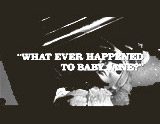
|
What Ever Happened to Baby Jane? (1962)
This gothic psychological thriller and black comedy by director Robert Aldrich was a tale of sibling rivalry - two feuding sisters who had lived together for their entire lives. It was noted by two taglines:
Its second tagline was a much longer exposition:
The two main characters were sisters:
In the early part of the film, in the mid-1930s, decades before the present day of 1962 - a pivotal incident was partly shown, to explain the reason for Blanche's crippled condition and paralysis. There was a mysterious car accident involving the two sisters, their out-of-control vehicle, and their Los Angeles mansion's big iron gates. It was thought that Jane was drunk and at the wheel, and that she had crippled her older sister with attempted murder (by crushing her between the car and the gate) out of jealousy for her successful acting career.
It closed with a beach scene, where a decades-old secret regarding the car accident was revealed. "Baby" Jane drove the two of them in their black convertible to the beach in Santa Monica to evade authorities, knowing that sooner or later, she would be charged with the bludgeoning hammer-murder of their suspicious black cleaning lady Elvira Stitt (Maidie Norman). Radio reports and headlines in the newspaper told about a kidnap-slaying mystery: "HUDSON MAID FOUND IN VENTURA SUBURB." (Jane had dumped the body in a garbage dumpster miles from the home) Blanche, looking starved and dehydrated and admitting that she was dying, told her sister the truth about the car crash accident that had paralyzed her. The revelation was that Blanche had been the one behind the wheel of the car, crippling herself with a spinal injury (snapped vertebrae) when she tried to run over drunken Jane standing before iron gates, because of the embarrassment and bad press Jane was giving her. "Baby" Jane had moved out of the way just in time, but was so drunk that she didn't know what had transpired. Blanche had managed to crawl out of the car to the gate - and when Jane saw her there, she thereafter blamed herself.
After being released from the guilt she'd felt over the years, Jane reacted:
Blanche finished her tale: "You were frightened and ran away. I managed to crawl out of the car up to the gates. When they found me, they assumed it was your fault. You were so drunk and confused, you didn't know any better. You weren't ugly then. I made you that way. I even did that. " The film's ending echoed the beginning when Jane purchased two strawberry ice cream cones for them. Two Los Angeles policemen, who had been alerted to Jane's car parked nearby, came up to Jane and asked for the whereabouts of her sister Blanche - the last two lines of the film:
Without answering directly, Jane insanely and happily spun, pirouetted and danced, drawing a curious circle of people around her to fulfill her attention-craving desires. The officers discovered Blanche for themselves lying motionless on the beach, as the film concluded. (Whether Blanche was dead or not was left uncertain!) |
 "Baby" Jane Hudson (Bette Davis)  Blanche Hudson (Joan Crawford)  Jane with Dying Blanche at Beach    Blanche's Confession to Shocked Jane  "Then you mean, all this time we could have been friends?"  The End of the Tale: "They assumed it was your fault."  Jane Questioned by LAPD Officers  Surrounded by Curious Beachgoers 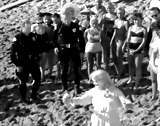  Spinning and Twirling  Finding Blanche's Body |
||||||

|
What Lies Beneath (2000)
This Robert Zemeckis supernatural, psychological horror film told of an underlying problem in a dysfunctional marriage and secrets from the past - not revealed until the conclusion. Its taglines were:
The seemingly happily-married couple who were living together in a remodeled lake-front Vermont home in the late 1990s were:
As the film progressed, Claire became increasingly agitated, first due to the departure of her daughter Caitlin (Katharine Towne) (Norman's step-daughter) for college (the "empty nest" syndrome), and Claire's own memory lapses (due to a car accident a year earlier in which she plowed into a tree - was it deliberate?). Her paranormal beliefs also began to haunt her. She became very suspicious of her contentious next-door neighbors:
At one point, she feared that Mary had been murdered by her husband Warren, and that she was being contacted by Mary's 'ghost.' Her suspicions proved to be unfounded and wrong - and a lengthy red-herring for over half of the film. However, after other premonitions, investigative sleuthing (with best friend Jody (Diana Scarwid)), and contact with the supernatural, she began to suspect and deduce that her husband was involved with one of his very gifted students - who was discovered missing since the previous year, and was presumed to have run away by police ("Most people around here think she's off tooling around Mexico somewhere with her friends"):
Claire deduced that her husband had an affair with Madison before she went missing. Norman finally admitted to Claire: "Out of nowhere, some bright young woman finds me attractive...and I slipped." She also reasoned that it was possible that the unstable young student allegedly threatened to kill herself - or Claire:
The only thing that made sense to Claire was that the young woman was not missing, but dead, and haunting Claire with paranormal apparitions of herself. It all was thought to have happened as a result of Claire taking a braid of Madison's hair at her house when speaking to her mother - causing a psychic connection between the two. But then, Norman was forced to explain to Claire what happened to Madison - he claimed that she had died from a drug overdose in their house ("When I got here, she was already dead. She killed herself here in our house to destroy me...When I got here, she'd taken pills. I, I tried to revive her, but she was gone. There was nothing I could do. So-- So I put her in her car, and l-- I drove to the boat ramp and I rolled it out into the lake.") When Claire was about to notify police with more information about Madison's disappearance (and presumably have the lake dredged), Norman was forced to take more drastic steps with Claire. He finally admitted that he murdered Madison when she had threatened to expose their affair to the school's Dean ("She was going to go to the Dean. She would have ruined us. Did she think I was just gonna sit there and watch it happen?"). It was not suicide by a drug overdose, but a covered-up murder. To keep Madison quiet because he had no other recourse, the unfaithful Norman had killed her by drowning her ("You have no idea what it was like to hold her underwater, watch her life slip away"). He then put her body in her car, and submerged it in the lake. Now, he threatened to also murder Claire: "But she gave me no choice. And neither have you." He would drug Claire with a paralyzing agent and drown her in their bathtub and make it look like a suicide. When he was in the process of drowning the paralyzed Claire in the bathtub, he spoke about how Claire's death would bring him closer to his step-daughter Caitlin (it was one of the last major lines of dialogue in the film):
[Note: The original bathtub scare scene was in French director Henri-Georges Clouzot's psychological horror-thriller Les Diaboliques (1955, Fr.) (aka Diabolique), and also repeated in The Shining (1980) and Fatal Attraction (1987).] Then, after kissing his frozen-in-fear wife, he noticed Madison's pendant around her neck. (It was the necklace-pendant that Claire had found earlier in a jewel-box in the nearby lake.) As he removed it, Claire's face momentarily morphed into the face of the deceased Madison. In shock, Norman slipped, knocked his head on the sink, and fell unconscious to the floor. In the film's exciting conclusion, she had revived (and saved herself from drowning by removing the bathtub plug and reducing the water flow) and Norman had crawled downstairs. To escape from the house, Claire drove off in their truck, not realizing that Norman had jumped into the boat being towed by the vehicle. After breaking the cab window, Norman struggled to grab the wheel from behind and to strangle her. She swerved to avoid a ghost-like figure in the road, and their vehicle plunged into the lake. As the truck began to fill with water and sink and Claire struggled to get out (while Norman was recovering from the crash), the sunken car with the dead student's body became visible beneath them (referencing the film's title 'What Lies Beneath'). The truck crash dislodged Madison's corpse from the earlier wreckage. Floating upwards, the 'ghost' corpse of Madison with outstretched bony arms held Norman back during the struggle, allowing Claire to disengage and swim to the surface, while Norman fatefully drowned with his foot entangled.
In the final scene, Claire put a red rose on the dead student's wintry grave, and some viewers claimed they could see an image of Madison's face in the snow. |
  Claire Spencer (Michelle Pfeiffer) - Paralyzed and Being Drowned   Dr. Norman Spencer (Harrison Ford)  The Kiss  Removing Madison's Pendant from Claire's Neck  Claire Morphing into Madison's Face  Knocked Unconscious  Saved From Drowning   In the Sinking Truck  A Rose For Madison's Grave  Woman's Face in Snow Between Rows of Graves |
||||||